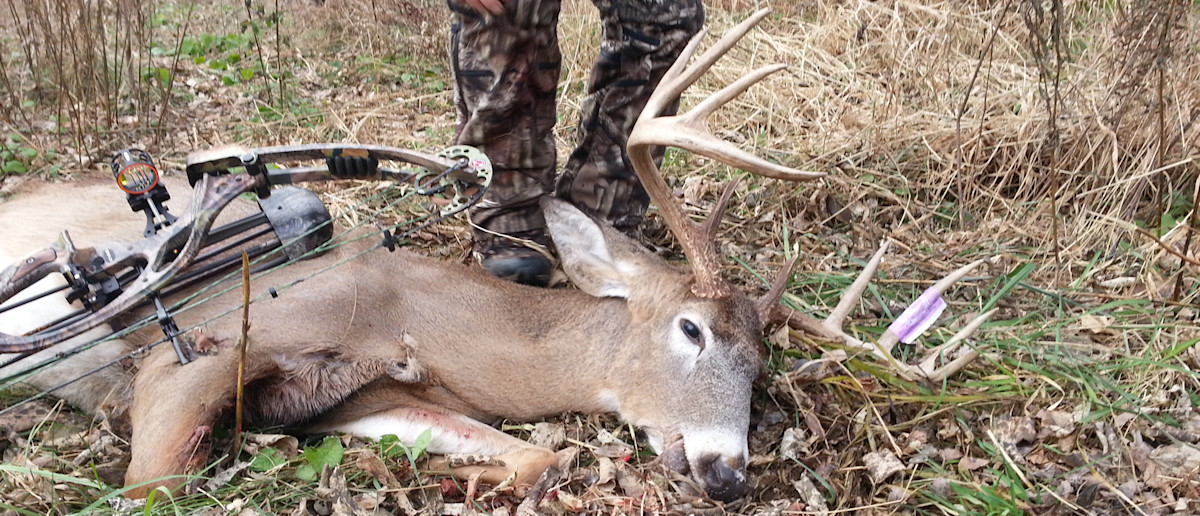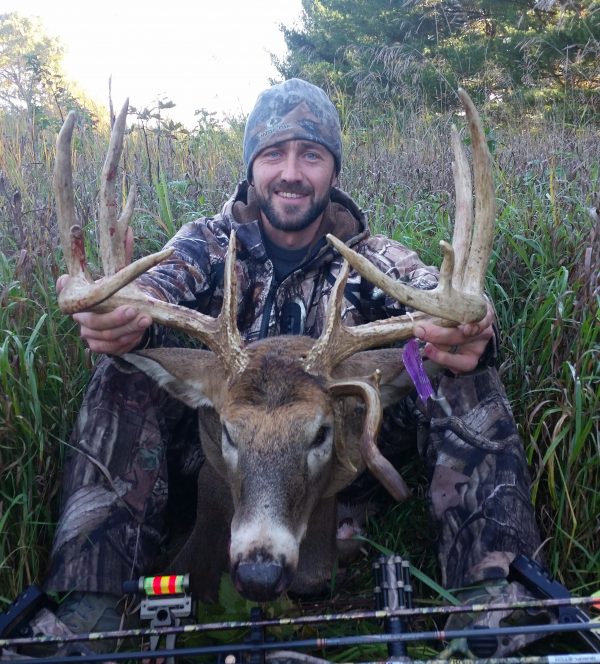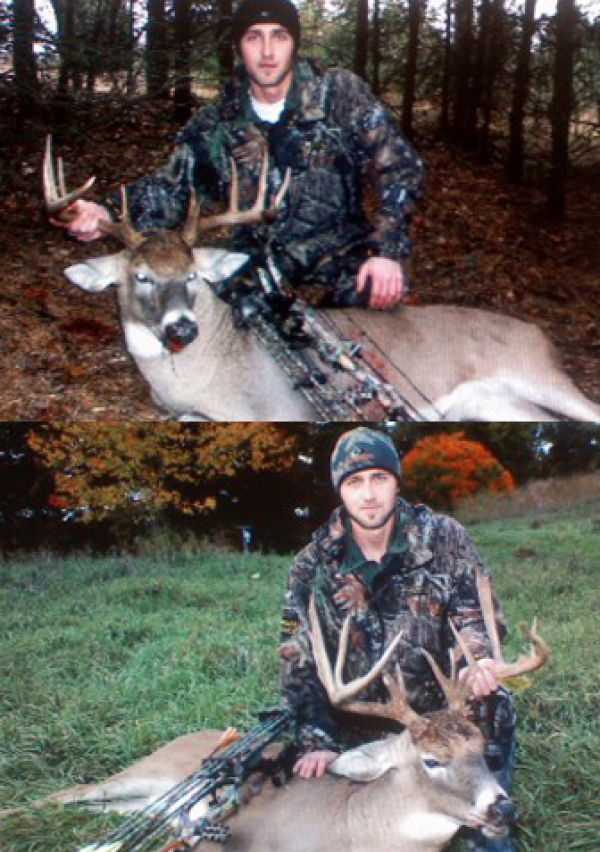
By Andy May
We’re back with another DIY Deer Hunter Profile and today we’re featuring Nick Wolf, a hunter from southern Michigan – which is one of the most pressured areas to whitetail hunt in the country. He hunts on a variety of small parcels and is always competing with other hunters. Somehow, Nick is able to wrap his tag around beautiful Michigan bucks nearly every year where very few other guys do. He’s a natural and just plain knows how to get it done. Read along as Nick explains how he consistently finds success in the heavily hunted state of Michigan.
Q: Tell me about the places you hunt.
A: The land I hunt in Michigan is private consisting of parcels from 10 acres to 80 acres and in southern Michigan the pressure is always increasing.
Q: You are a go getter – always getting after it in one way or another. What motivates you?
A: What motivates me the most each year, 365, is friends and family and as much as I hate to say it social media. With all of these things added together I think and talk hunting all year. When I see guys spring shed hunting, turkey hunting, planting summer food plots, putting down minerals, mushroom hunting… it all motivates me. It’s always on my mind.
Q: You seem to get it done every year in an area where nobody really does. What has been your most effective tool to get big bucks on the ground consistently?
A: My most effective tool to get big bucks on the ground consistently is definitely patience and perseverance, whether it’s hunting mid-day or all day if you know there’s that buck you have trail cam pics of or glassed from the road all summer and conditions are right with wind and temps. I simply stay put. That one extra hour or two can be all the difference. I have taken many target bucks in-between the hours of 11:00 am and 2:00 pm.
Q: What type of areas do you look for when getting on big bucks in your area?
A: The type of areas I really like to find are bottle necks out from bedding areas that are typically thick in cover that make it hard to hunt and even harder to get into the stand. Wind is huge for these setups and sometimes the hunt ends right at first light or right at last light. I have learned that keeping my bow in hand and release on at these times helps me when the scenario unfolds. The last thing I want to do is miss the only opportunity I have, so I am always ready.
Q: In your opinion what are some of the key things that you do differently that allows you to succeed when most hunters fail?
A: First off, my scent regime is nothing but consistent and I stay on top of it all season. I treat every time I head to the woods like it’s opening day – fresh and clean. I get out before most and never ever rush. I have killed two of my biggest bucks on the way to and from my stand, a 165” 15 pt nontypical and 155” 22” inside spread 10 pt. I take my time and stop more often the closer I get to my stand. With that said, I honestly couldn’t tell you the last time a deer busted me on my way to a stand. I always leave with enough time to quietly get to my stand without being detected, morning or afternoon sits.
The three things the average hunter can improve on in my opinion are #1. Shoot shoot shoot. Not just dial in at 20 yards, but challenge your shots just like they would be challenged in the woods. Try a 3D course or shoot your maximum distance 10x more than your everyday comfort distance. I shoot 60 yards and group tightly from there but I also know every pin on my bow is right where I need it. When you shoot enough that it feels like second nature you will put more arrows on the mark when a giant buck gives you that rare opportunity. 2. Confidence, have the confidence in your shot that if a big buck walks out you can do your part to make a great ethical kill. Something I really like to do for myself is to shoot a doe before I take a buck. Nothing says you’re ready for a great season than taking a big beautiful doe with a great shot. It is definitely a confidence booster. 3. Hang more stands! I have stands for does, stands for glassing deer, and I have kill stands. Heck I even have a couple stands for calling coyotes. I do not hunt a certain stand if the wind isn’t favorable and I sure as heck don’t over-hunt any one stand. That will reduce the quality of your hunt and quantity of animals quickly.
Q: Can you describe those aforementioned hunts? How were you able to shoot your two biggest while walking to your stand?
A: In 2007 I had an encounter with a giant buck. He came out of a swamp, heading my direction that evening. The plan was to set back up on him the next chance I had but closer to his bedding. On the way into the stand I took a knee and stayed there for five minutes or so looking into the bedding area for any signs of deer on their feet. I checked the wind a few times. Feeling pretty good about it I took a few steps on the hard dry leaves and stopped. I reached only 20 feet into the timber and I could hear deer running around. It was a young 4 pt and the buck I was after. The 4 pt ran out of the bedding and right in front of me. He started walking away continuously looking back into the thick bedding. I eased down the trail a little closer trying to keep my eyes on both bucks. The big buck approached grunting loudly and chased the young buck off. The big buck, preoccupied with running the younger buck off finally closed the distance and offered me a shot. The rest is history!
Q: How would you describe your style of hunting?
A: My style of hunting is plain and simple. I put my time in the woods when it’s needed so when the season unfolds I already have it setup to hunt. I scout a lot outside of hunting season and have trail cams up from June until March and sometimes later. Doing so helps me find out how the buck-doe ratios are year to year and what bucks survived after the season is over. It tells me how the predator population is also. If I see lot of predators I like to run a trap line sometimes through hunting season for raccoons or just after season for coyotes. Doing this helps me out the next year for fawns and not having the added pressure in the woods. I’ve had a few coyotes ruin my hunts so keeping the population in check never hurts. For instance on a 80 acre parcel I hunt in 2015 I trapped 12 coyotes, one of which being a 42lb male. I feel that if I want to be successful in the woods each year I can improve the property now and pave the way for a better hunting season later.
Q: What pieces of equipment are essential for your style of hunting and directly attribute to your success?
A: There are many pieces of equipment that I attribute to being successful. One thing I concentrate on the most and use the most is a bottle of windicator. I go through 2-3 a year. I’ve learned a long time ago that if I don’t beat a deer’s nose my hunt is over before I even get settled in my stand. I also have back up stands setup for when the best wind in my (kill) stands starts to swirl or change direction. Then I am able to back out 100 yards or so in a (satellite) stand, grab the binoculars and still see what’s happening in the cover or bedding. This way I’m not spooking anything out and keeping future success in those spots possible.
Q: One of the things that I find most interesting about you is your drive. You have a drive that is rare these days. Where does that come from?
A: My drive- I have to say for sure comes from my grandparents. Both my grandpa and grandma taught my brother and I everything in the woods. They were such great teachers of patience and knowledge and they made sure to pass that on to us. My grandpa lost his eyesight in 1991. If I told him I was going out hunting with my muzzleloader and had a comfy spot for him to sit he would come every chance he got. I always loved passing the time in the woods with either of them. I’ve sat countless hours with both even before I could legally hunt but when it was time to let us go on our own they were the first ones there to see our trophy or help take up the trail. My grandpa would fire up the old Ford tractor and him and I would get my deer out of the woods, while grandma waited up at the house with a huge smile for when we got back. My grandma and I would cut up the deer taking every morsel (they grew up in the depression). Those were the days. Grandma hunted until she was 90 and even today she loves to hear my stories after the hunt. The way they taught us to care for each animal, be thankful for it, and not to take more than what you need puts a drive in me so I can pass that on to my son and always better our hunting heritage.
Q: 40 years from now, when you look back on your hunting career, what do you want to see?
A: In 40 years I want to look back and see that I was able to pass along the hunting heritage I was taught. To have my son and his kids out enjoying creation just like I did, along with a house full of trophies to prove this old man knows what he’s talking about.





